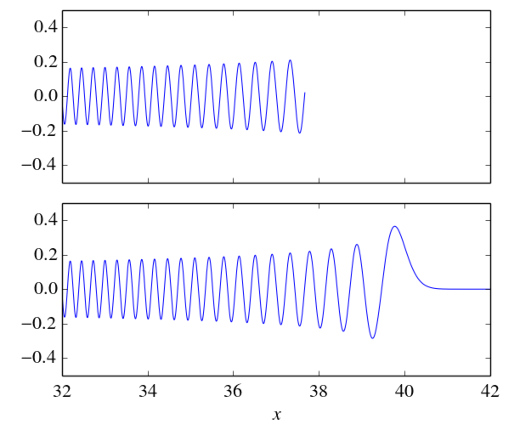The Hermite functions appear as the solutions of the quantum mechanical harmonic oscillator. But they have applications in many other fields and applications, e.g., pseudospectral methods. The Hermite functions $h_n(x)$ are defined as
\begin{equation}
\label{eq:h}
h_n(x) = \frac{1}{\sqrt{\sqrt{\pi} 2^n n!}} \mathrm{e}^{-x^2/2} H_n(x) \,,
\end{equation} where $H_n(x)$ denotes the $n$th Hermite polynomial defined via the recurrence relation
\begin{equation}
H_{n}(x) = 2xH_{n-1}(x)-2(n-1)H_{n-2}(x)
\end{equation} with the initial values $H_0(x)=1$ and $H_1(x)=2x$. Although the Hermite functions are quite well behaved, they are rather difficult to calculate especially for large $n$ and/or large $x$.
Calculating the Hermite functions via the definition \eqref{eq:h} fails easily due to numerical overflow or underflow that is caused by the rapid growth or decrease of the individual factors $\frac{1}{\sqrt{\sqrt{\pi} 2^n n!}} \mathrm{e}^{-x^2/2}$ and $H_n(x)$. A partial solution to this problem is to introduce the modified Hermite polynomials defined via the recurrence relation
\begin{equation}
\label{eq:h2}
\tilde H_{n}(x) = \sqrt{\frac{2}{n}}x\tilde H_{n-1}(x)-\sqrt{\frac{n-1}{n}}\tilde H_{n-2}(x)
\end{equation} with the initial values $\tilde H_0(x)=1/\sqrt[4]{\pi}$ and $\tilde H_1(x)=\sqrt{2}\,x/\sqrt[4]{\pi}$. With these polynomials the Hermite functions become
\begin{equation}
h_n(x) = \mathrm{e}^{-x^2/2} \tilde H_n(x) \,.
\end{equation} Because the modified Hermite polynomials $\tilde H_{n}(x)$ grow much more slowly than the standard Hermite polynomials we got rid of the normalizing factor $\frac{1}{\sqrt{\sqrt{\pi} 2^n n!}}$.
But this does not solve all problems of underflow and overflow. For $x>38$ the factor $\mathrm{e}^{-x^2/2}$ is smaller than any number that can be represented as a double precision floating point number. A very robust remedy to numerical underflow was sketched in BIT Numerical Mathematics, Vol. 49, pp 281-295. The basic idea is to keep the magnitude of the modified Hermite polynomials on the order of one during their calculation via the recurrence relation \eqref{eq:h2} by introducing a suitable normalizing factor. During the calculation one has to keep track of the sum of the logarithms of these normalizing factors. Then the factor $\mathrm{e}^{-x^2/2}$ has to be modified by this sum when the value of the Hermite function is calculated. A Python implementation of this algorithm is shown below. This algorithm allows to calculate the values of high-order Hermite functions even for quite large arguments.
from numpy import *
from pylab import *
def h(n, x):
if n==0:
return ones_like(x)*pi**(-0.25)*exp(-x**2/2)
if n==1:
return sqrt(2.)*x*pi**(-0.25)*exp(-x**2/2)
h_i_2=ones_like(x)*pi**(-0.25)
h_i_1=sqrt(2.)*x*pi**(-0.25)
sum_log_scale=zeros_like(x)
for i in range(2, n+1):
h_i=sqrt(2./i)*x*h_i_1-sqrt((i-1.)/i)*h_i_2
h_i_2, h_i_1=h_i_1, h_i
log_scale=log(abs(h_i)).round()
scale=exp(-log_scale)
h_i=h_i*scale
h_i_1=h_i_1*scale
h_i_2=h_i_2*scale
sum_log_scale+=log_scale
return h_i*exp(-x**2/2+sum_log_scale)
I would like to thank Randolf Beerwerth for drawing my attention to this problem.
Edit 12.06.2020: A typo in eq. \eqref{eq:h2} has been fixed.

The code provided is incomplete. “norm” is not defined.
Well spotted. Thanks. Python code has been fixed.
Hi,
thanks for the excellent post.
I notice that there is a problem with the case n=1.
At this line there is an extra exp(-x**2/2)
return sqrt(2.)*x*exp(-x**2/2)*pi**(-0.25)*exp(-x**2/2)
It should be just:
return sqrt(2.)*x*exp(-x**2/2)*pi**(-0.25)
Thanks for drawing my attention to this typo. I will fix it.